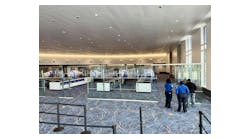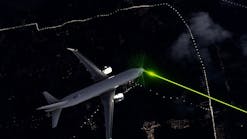How Miami’s Airport is Strengthening Security Against Intruders Outside the Terminal
Security at Miami International Airport is much more than the TSA line passengers wind through before reaching their gates. It’s also the surrounding highways and roads that millions of drivers use.
For that reason, the airport is boosting its security outside, with new technology that makes it harder to penetrate a 13-mile fence surrounding the property. MIA unveiled the “perimeter intrusion detection system” on Oct. 22.
The system uses a mix of fiber optic sensors, video surveillance, laser walls and radar to get law enforcement quickly into position if someone tries to break through the barrier.
As Miami International continues to transport record numbers of passengers as a global hub — it’s the nation’s second busiest for international travelers and the area is a host city for the 2026 soccer World Cup — airport leaders say tightening security a top priority.
The stronger security at the fence “puts MIA at the cutting-edge in all airport security among all United States airports,” Mark Hatfield, the airport’s assistant director for public safety and security, said at a demo at the airport on Oct. 22 as more than a dozen planes touched down behind leaders showing off the new tech,
How does the airport security fence work?
In the live airfield demo, an intruder tries to cut part of the south perimeter fence. A sensor then sends a signal to a nearby camera, which rotates toward the trespasser, and captures an image. A signal and the image then go to an airport operations center, which decides whether to dispatch police or agents.
The entire process takes seconds.
Before the system was introduced, the same fence with razor-wire and concrete barriers surrounded the perimeter. MIA also had cameras, and patrol cars roamed the area.
What’s new is the fiber-optic sensors, LiDAR — a combination of radar and laser — and faster and more accurate video surveillance and video analytics. The sensors and radar more effectively detect impact against the fence. For example, they can distinguish between heavy winds and a person scaling the fence. They also follow movement — the trespasser leaves a trail wherever he goes.
The new system “identifies the concern quicker, [and so] we can respond faster,” said Jim Bamberger, director of multimodal and public area capabilities at TSA.
Additionally, several new cameras and control boxes are spread through the area, meant to catch any “insider threat,” said airport spokesperson Greg Chin, or employees already on the airfield looking to do damage. The demo showed that any attempt to disable or mess with the control box also triggers a response to the operations center and an immediate response by law enforcement.
Miami International is the first U.S. airport to run the new security fence. But MIA has only covered half of its perimeter with the new system. The second half will take another two years to complete.
Past intrusions at the airport
In 2010, someone showing off for friends broke into a secure area and took a ride on the airport baggage carousel, ending up in a secure area on the other side. In January 2018, a man jumped the perimeter fence and sprinted down Runway 9, looking to take a “shortcut” to catch his flight. That was the second time in four months such thing occurred. In September 2017, 34-year-old Kentucky man drove his truck through a locked gate onto airport grounds, and then scaled another fence. And in 2015, a California woman scaled the airport fence, CBS News Miami reported.
Chin, communications director for Miami-Dade Aviation Department, told the Miami Herald that three people have breached the perimeter fence in the last three years while nine vehicles crashed into it in the last year. He and other MIA and TSA officials declined to provide specifics, citing security.
How the Miami airport got the security fence
The new security system has been several years in the making.
Congress gave $10 million about four years ago to the Transportation Security Administration, earmarking it to helping enhance airport perimeter security, the TSA’s Bamberger said.
The Miami airport got $6 million of that, and will pick up the rest of the cost. San Jose Mineta International Airport, which has not yet rolled out the fortified fence, got $4 million.
TSA sought airports with a large volume of departures and arrivals, extensive foreign travel and growth in cargo transport, he said. Perhaps more important, they wanted a challenging geographic environment.
Obtaining the different technologies took about one year. Senstar provides the fiber-optic sensors. Echodyne developed the ground-based radar. Optex does the laser wall and LiDAR, a combination of radar and laser. Axis provides the video surveillance and analytics.
©2024 Miami Herald. Visit miamiherald.com. Distributed by Tribune Content Agency, LLC.


